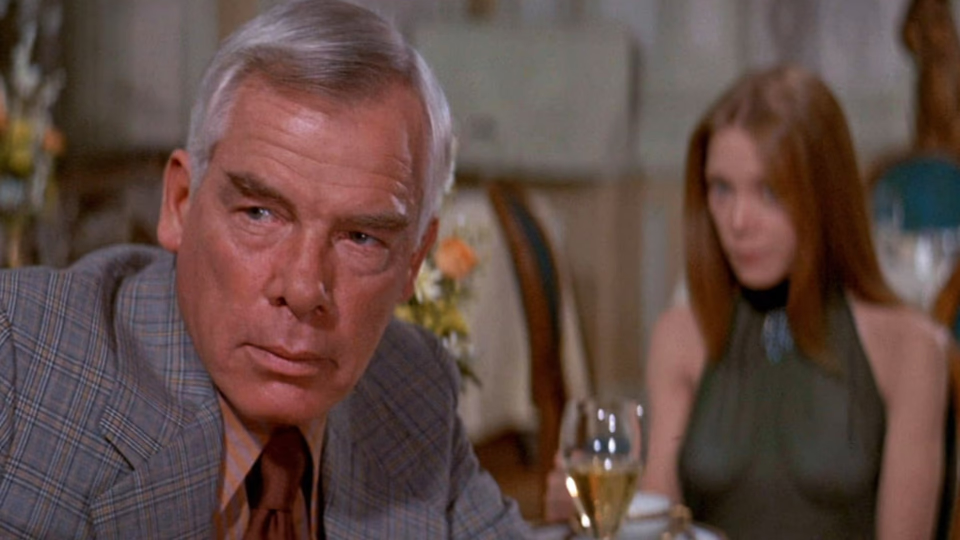Prime Cut

Michael Ritchie’s Prime Cut is a curious beast—a crime thriller that wants to be both brutal exploitation and artful commentary on American values, held together by the steely presence of Lee Marvin and undermined by dialogue that sounds like it was written on cocktail napkins.
The plot is deceptively simple: Marvin plays Nick Devlin, an enforcer hired by the Chicago mob to collect a half-million-dollar shortage from their Kansas City operation, headed by Mary Anne, played by Gene Hackman. Once in Kansas City, Devlin discovers Mary Anne is running a forced-prostitution ring from which he rescues a girl, Poppy, played by Sissy Spacek.
The film’s brisk 88-minute runtime suggests significant editing, with several plot threads introduced then dropped without ceremony. This isn’t necessarily a flaw; there’s something hypnotic about the film’s refusal to linger on conventional beats. When Devlin takes the rescued Poppy to dinner, we expect the standard seduction scene. Instead, Ritchie gives us something more interesting: Marvin’s quiet chivalry as he protects her from the leering stares of other diners, a moment that reveals character through action rather than exposition. The editing also creates some effective juxtapositions, like the intercut sequence between a cow-roping contest and Devlin and Poppy fleeing Mary Anne’s henchmen at the fair.
Indeed, the film’s greatest strength lies in its visual poetry. Cinematographer Gene Polito captures the Kansas wheat fields with an almost biblical grandeur—endless golden seas under storm-darkened skies. The contrast between the urban grit of Chicago and the pastoral menace of rural Kansas creates a unique atmospheric tension. When Marvin and his men drive toward their final confrontation, their car cutting through those wheat fields while thunder rolls overhead, the image carries more weight than pages of dialogue could manage.
And it’s fortunate the images are so strong, because the dialogue is catastrophically weak. When Devlin discovers a case full of cow hearts instead of cash, he declares, “You just bought the farm.” Mary Anne’s retort? “Not me, you.” This tin-eared exchange typifies the script’s reliance on clichéd tough-guy banter that would embarrass a pulp novelist.
When its characters aren’t speaking, Prime Cut contains moments of genuine power, particularly in its handling of the prostitution subplot. The scene where Devlin finds Violet, one of Mary Anne’s discarded victims, is devastating in its restraint. As he helps her to her feet, nickels—payment from her johns—spill from her hand to the floor. It’s an image that speaks volumes about exploitation and degradation without a word of dialogue. How a film capable of this kind of visual poetry can also include lines like “You just bought the farm” remains one of cinema’s enduring mysteries.
Marvin anchors the film with his characteristic deadpan authority. His Devlin is cut from the same cloth as his Walker in Point Blank—a man of few words and efficient violence—but with a moral compass that wasn’t present in that earlier antihero. Gene Hackman, sweaty and reptilian, makes an effective villain but feels underused, as if larger scenes were left on the cutting room floor—perhaps a casualty of the atrocious dialogue.
The film’s action sequences have a raw, analog power that modern CGI spectacles would do well to study. Watching a combine harvester literally chew up a sedan, or a semi-truck demolish an entire greenhouse, carries visceral impact precisely because we know these are real machines causing real destruction.
Prime Cut is a fascinating near-miss—a crime thriller that works when it trusts its images and stumbles when it opens its mouth. It might have achieved greatness with a script polish from someone like Walter Hill, who understood how tough guys actually talk. That it succeeds at all is testament to the skills of its cast and the visual flair of its director. Like many films of its era, it takes chances that modern studio products wouldn’t dare, and while not all of them pay off, the ones that do make it worth the price of admission.